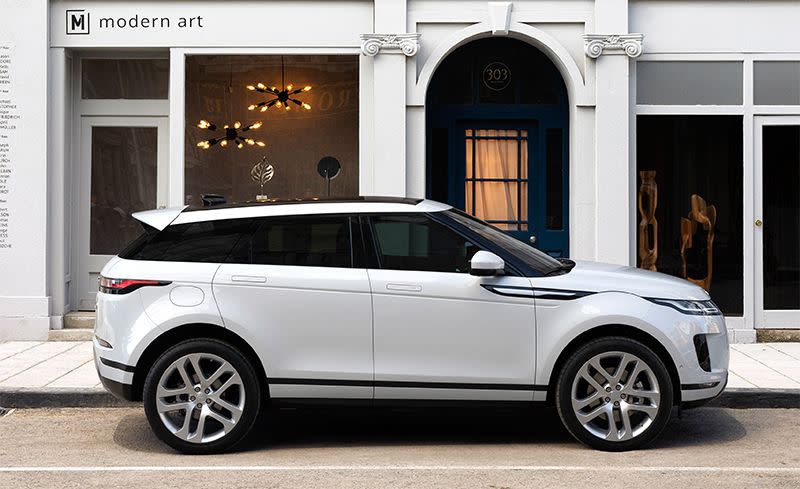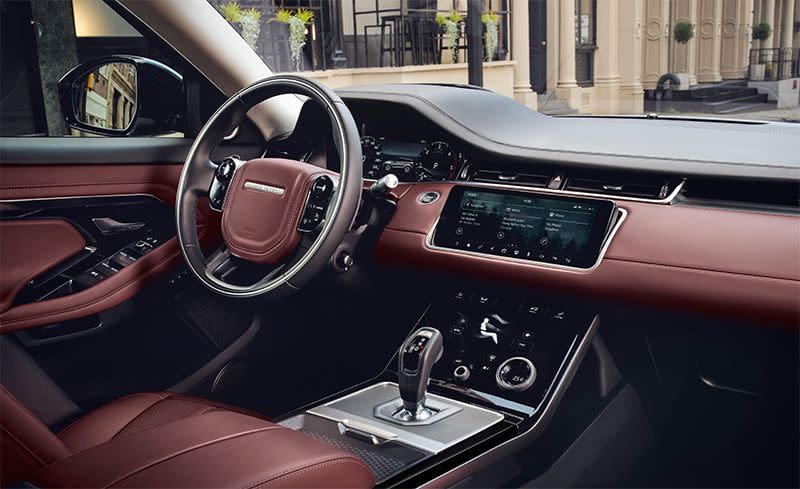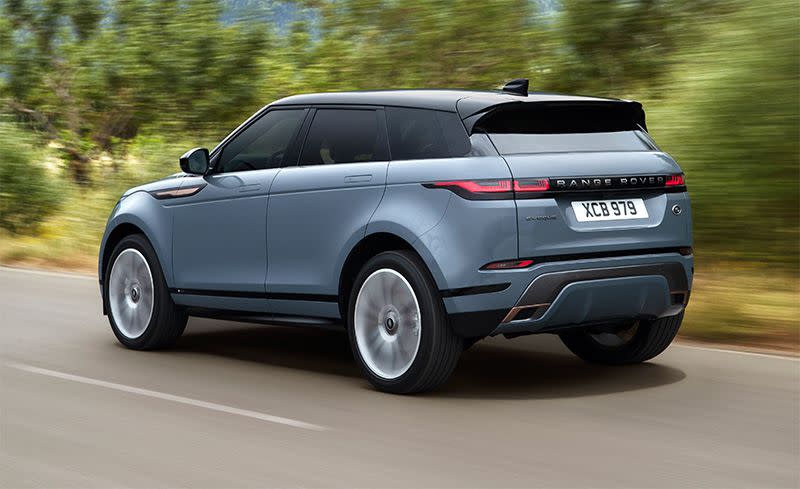The 2020 Range Rover Evoque Is an Evolution, Not a Revolution

UPDATE 2/7/19: The new Evoque has made its auto show debut in Chicago, and Land Rover has released U.S. pricing and performance specs for the all-new crossover. We have updated the story with the new info.
The first Range Rover Evoque wasn't a huge hit on this side of the Atlantic, but it was a significant car for its parent company. Land Rover had a miserable time in the most recent recession, and it was this baby Range Rover, launched in 2011, that helped to transform the brand's fortunes. Globally, it never sold fewer than 100,000 units a year throughout its life, a major number for Land Rover.
The first Evoque served its part of the market well, which is why we are unsurprised that the new Evoque, which has just been introduced at a swanky launch event in London ahead of its arrival next year, sticks closely to its predecessor's formula. It sits on what is described as the brand's new Premium Transverse Architecture, which company insiders have previously told us is a substantial development of the D8 architecture that underpinned the first-generation model. Dimensions are barely altered-the overall length of 172.1 inches makes it just 0.6 inch longer than the current car-with the wheelbase stretched 0.8 inch, to 105.6 inches. Land Rover claims that this modest extension has been entirely translated into a corresponding increase in rear-seat legroom, which is welcome news given how tight the existing Evoque feels in back. Luggage capacity has also risen slightly, to a still petite 22 cubic feet with the rear seats in place, but this is accessed through a wider tailgate.
There was nothing wrong with the way the first Evoque looked. After all, the LRX concept that inspired it was the work of Julian Thompson, whose résumé also includes the Jaguar F-type and the original Lotus Elise. The new Evoque's appearance is only mildly evolved. The two-door "coupe" version has been dropped, for now at least, but the Mark 2 Evoque shares the proportions and rising beltline of the original, with the windows tapering toward the rear of the car. Narrower, more elongated LED headlights look similar to those of the handsome Range Rover Velar. The Evoque also gets that car's hidden door handles, which sit flush with the body when not in use.

The cabin draws similar inspiration from the larger members of the Range Rover clan, with high-class materials and an emphasis on technology. The new Evoque has digital instruments and a twin-touchscreen version of JLR's InControl Touch infotainment system. The lower interface controls climate, seat adjustments, and the car's broad range of dynamic modes, including Terrain Response settings intended to help it cope with a variety of different surfaces, plus an Auto setting for drivers who want to let the car worry about such details. It also gains a conventional gear selector in place of the quirky rotary selector of the previous car.
The new Evoque's center console has grown, as have door pockets and stowage space for small items. In addition to the regular option of leather, buyers will be able to choose seats trimmed with Kvadrat, which is described as a Denmark-developed "durable wool blend" paired with a "technical suedecloth." A Eucalyptus cloth finish will also be offered; both choices are designed to appeal to those seeking a cabin free of animal products.

Land Rover is particularly proud of two high-tech options. A front-facing system called ClearSight Ground View uses video cameras in the grille and door mirrors to create a video feed to look ahead of, and underneath, the front of the car. We're told it was designed for both off-road use and for avoiding sharp-edged city curbs. A ClearSight Rear View system integrates a video screen in the rearview mirror, which can be switched on when passengers or luggage block the view through the dinky rear window; the company notes that the 50-degree field of view is wider than a standard mirror offers.
Mechanically, most is familiar. This Evoque still uses front strut suspension and a multilink rear axle and continues with the transverse-mounted version of JLR's 2.0-liter turbocharged Ingenium gasoline four-cylinder. There are two outputs offered, 246 and 296 horsepower, with the brawnier one also featuring a 48-volt hybrid system. Land Rover says the 246-hp version, which is dubbed P250, will hit 60 mph in 7.0 seconds, while the more powerful P300 model will make the spring in 6.3 seconds. Claimed weights are 3935 pounds for the base car and 4075 pounds for the P300.

Power passes through a standard nine-speed automatic transmission and is sent to each corner through an all-wheel-drive system that is now capable of fully decoupling drive to the rear axle to help boost economy. The brawnier P300 model features active torque vectoring; we don't yet know if this is with the innovative Twinster system that was offered on the first-generation Evoque, which was closely related to the active back axle of the now retired Ford Focus RS. The springs are steel, but adaptive dampers will be offered as an option; 18-inch wheels will come as standard, with upgrade options up to 21 inches. Land Rover claims 8.3 inches of ground clearance and the ability to pass through up to 23.6 inches of water, nearly four inches more than the last Evoque.
The hybrid system is the most substantive technical innovation. Working with the more powerful engine, this uses a belt-driven starter-generator to generate electricity under braking. It is stored in an underfloor battery pack, with the charge used to assist the engine at low speeds. Land Rover hasn't disclosed how much of a contribution the electrical side of the powertrain is capable of making, but we suspect it will be modest. For comparison, Mercedes-Benz's similar hybrid 48-volt system can add only 14 horsepower at most.
The new Evoque will go on sale in the spring. Pricing starts at $43,645 for the base S P250 model, just $850 more than the outgoing base car. Spending $47,595 nets you the R-Dynamic S P300 model, which has the 296-hp 48-volt hybrid system. The most expensive new Evoque is the R-Dynamic HSE P300, which starts at $56,795, but the price of every new Evoque can surely be inflated by tens of thousands of dollars when options are added. There's also a special P250 First Edition model, available in limited numbers, that is $57,845 and nets a unique color and different exterior trim.
('You Might Also Like',)

